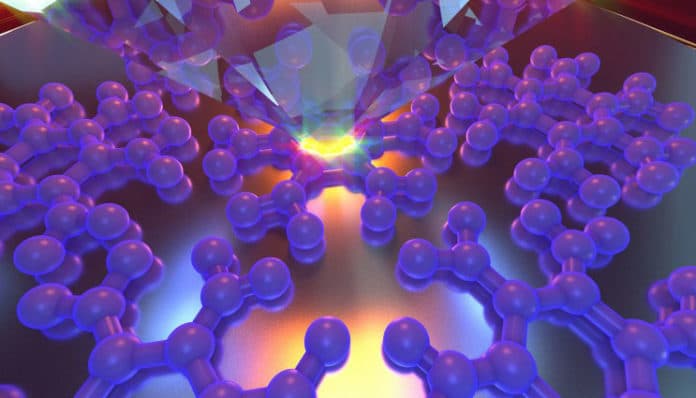Determining the unreacted equation of state of 1,3,5-triamino-2,4,6-trinitrobenzene (TATB) is challenging because it exhibits low crystal symmetry and low X-ray scattering strength.
The causes of this unusual behavior are hidden in the high-pressure structural evolution of TATB. Supercomputer simulations of explosives detonating, running on the world’s most powerful machines at LLNL, depend on knowing the exact locations of the atoms in the crystal structure of an explosive.
Precise learning of atomic arrangement under pressure is the foundation for anticipating the detonation performance and security of an explosive.
Lawrence Livermore National Laboratory (LLNL) scientists in collaboration with University of Nevada Las Vegas (UNLV) have Lawrence Livermore National Laboratory (LLNL) researchers in collaboration with University of Nevada Las Vegas (UNLV) have found a previously unknown pressure-induced phase transition for TATB that can help foresee detonation performance and safety of the explosive.
Scientists performed tests using a diamond’ anvil cell, which composed of TATB single crystals to a pressure of more than 25 GPa (multiple times barometrical weight). As per all past test and hypothetical examinations, it was trusted that the atomic arrangement in the crystal structure of TATB continues as before under pressure. Scientists challenged the consensus in the field aiming to clarify the high-pressure structural behavior of TATB.
Due to the extremely low symmetry crystal structure of TATB, it was not feasible to make conventional X-ray diffraction techniques for diamond anvil cells.
Thus, scientists used single-crystal X-ray diffraction under pressure, for the first time in the case of a low symmetry organic material such as TATB.
Oliver Tschauner, a professor in the department of geoscience at UNLV said, “We were sure our approach would eventually settle this issue—but it was much more challenging to find the answer than we had expected.”
Scientists were surprised to know that outcomes revealed a previously unknown transition to a higher symmetry monoclinic phase above 4 GPa. This allowed scientists to further determine the basic characteristics of the high-pressure crystal structure and the equation of state above the phase transition. However, the team did not stop at this point.
Elissaios Stavrou, a staff member in the Material Science Division at LLNL said, “Although the experimental results allowed us to apply important corrections to the TATB equation of state, we were determined to go one step further and understand the nature of the phase transition and the exact structure of the high-pressure phase.”
Moving on, scientists disclosed the high-pressure phase using an evolutionary structural search algorithm (USPEX) that helps explore the high-pressure structures of TATB.
The outcomes not only confirmed the experimental findings but also clarified the exact structure of the high-pressure phase.
Brad Steele, a postdoctoral scientist in the Material Science Division at LLNL and lead author of the research said, “Almost everything about a material can be derived from its crystal structure. In this paper, we show we can predict the crystal structure even for a large/complicated energetic material such as TATB. The methods used have many potential applications in the field of materials science.”
Matthew Kroonblawd, a staff member in the Material Science Division at LLNL, further explained: “TATB is notoriously difficult to model, but we were able to relate the old and new phases using generalized computational tools that we developed specifically for these complicated molecular materials. This new phase resolves conjectures that have persisted since the 1970s.”
Scientists are now planning to use the same combination of state-of-the-art experimental and theoretical techniques to discover possible phase transitions in other energetic materials.
The study is published in the journal Applied Physics Letters.
